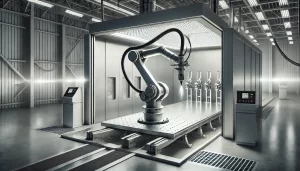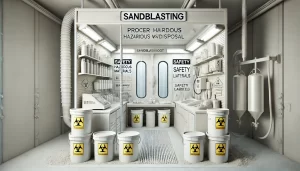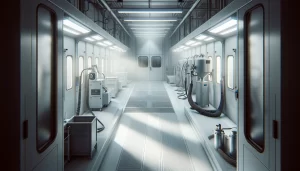Sandblasting is a highly effective method for surface preparation, cleaning, and finishing in industrial applications. However, it produces a significant amount of dust and debris, which can impact air quality, visibility, and equipment performance. Maintaining optimal airflow and dust control in a sandblasting booth is essential for ensuring efficiency, worker safety, and compliance with industry regulations. Proper airflow keeps contaminants moving away from the operator and prevents dust from settling on freshly blasted surfaces. Without it, airborne particles can reduce visibility, clog filters, and create an unhealthy work environment.
Understanding Airflow in a Sandblasting Booth
The way air moves through a sandblasting booth determines how well dust is controlled. An efficient ventilation system directs the flow of air so that dust and contaminants are continuously removed from the work area. There are typically two main airflow types used in sandblasting booths:
- Cross-draft airflow – Air moves horizontally from one side of the booth to the other. This is often achieved using intake vents and exhaust systems placed on opposite ends of the booth.
- Down-draft airflow – Air flows from the top of the booth and is pulled downward toward exhaust filters or vents at the bottom. This method is highly effective at capturing dust before it can become airborne.
Choosing the right airflow setup depends on the booth size, blasting material, and the type of work being done. Regardless of the system, maintaining consistent airflow is key to ensuring contaminants are effectively removed from the booth.
The Role of Dust Collection Systems
A sandblasting booth generates large amounts of fine dust that must be captured before it spreads into the workspace. A well-functioning dust collection system prevents dust buildup, reduces cleanup time, and protects both equipment and personnel. These systems typically include exhaust fans, filters, and ducts that pull contaminated air out of the booth and trap harmful particles before releasing clean air back into the environment.
Over time, filters can become clogged with dust, reducing their efficiency and restricting airflow. This can lead to poor visibility, longer blasting times, and increased health risks. To prevent these issues, regular maintenance of dust collectors is essential.
- Filter replacement – Check filters frequently and replace them as needed to prevent airflow restrictions.
- Air pressure checks – Proper airflow requires maintaining the right pressure balance inside the booth. Inspect fan speeds and ductwork for blockages.
- Duct cleaning – Dust can accumulate inside ducts, reducing efficiency. Regular cleaning ensures optimal performance.
A well-maintained dust collection system extends the life of equipment, improves visibility inside the booth, and keeps the workspace clean.
Preventing Dust Accumulation
Dust in a sandblasting booth doesn’t just affect airflow—it can also lead to contamination of the blasted surface, requiring additional cleaning and rework. To keep dust levels under control, it’s important to use proper blasting techniques and housekeeping practices.
- Use the correct blasting media – Different abrasive materials produce varying amounts of dust. Opting for low-dust media like steel grit or wet blasting methods can help minimize airborne particles.
- Keep surfaces clean – Regularly sweep and vacuum to prevent dust buildup on floors and walls.
- Seal leaks – Ensure that all seams, doors, and ventilation points are properly sealed to prevent dust from escaping into other areas.
Controlling dust at its source is the best way to maintain a clean and efficient workspace.
Monitoring Airflow and Ventilation
Even with a properly designed airflow system, it’s important to continuously monitor air movement within the sandblasting booth. This helps detect any inefficiencies before they become major problems.
- Visual airflow indicators – Using smoke or fog tests can help identify airflow patterns and pinpoint areas where dust is not being effectively removed.
- Manometers and pressure gauges – These devices measure air pressure inside the booth and indicate whether the ventilation system is operating correctly.
- Employee feedback – Operators working inside the booth can often notice changes in air quality or visibility before technical issues arise. Regularly check in with workers to ensure conditions remain optimal.
By keeping an eye on airflow performance, adjustments can be made quickly to maintain a safe and efficient sandblasting process.
The Impact of Proper Maintenance
Keeping a sandblasting booth in top condition requires regular inspections, scheduled maintenance, and proactive problem-solving. Neglecting airflow and dust control can result in poor surface finishes, excessive wear on equipment, and increased exposure to hazardous dust particles.
A well-maintained booth not only protects workers from harmful contaminants but also improves productivity. When airflow is properly regulated, blasting operations run smoothly, reducing downtime and the need for rework. Additionally, maintaining dust control helps businesses comply with industry safety standards, avoiding costly fines and regulatory issues.
Specialized Sandblasting Booth Services
We specialize in providing top-quality sandblasting booths and custom finishing solutions tailored to meet the unique needs of various industries. Our expert team designs and manufactures state-of-the-art sandblasting booths that ensure safety, efficiency, and superior performance. From automotive and aerospace to marine and industrial applications, our booths are engineered to handle even the most demanding surface preparation tasks. We offer comprehensive services, including booth installation, maintenance, upgrades, and technical support.




